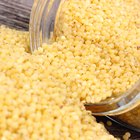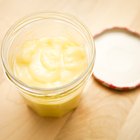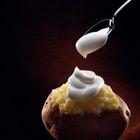
Dairy products, such as milk, butter or cream, are said to be “cultured” when they go through a fermentation process that gives the product a slight tang. This process restores many of the good-for-you bacteria that are lost during pasteurization, and also helps to break down the difficult-to-digest milk protein known as casein. Both sour cream and creme fraiche – a European sour cream – are considered cultured creams, and each have their place in desserts, dips and cooking sauces.
The "Sour" in Sour Cream
Sour cream is made by adding lactic acid bacteria to light cream that has been brought to room temperature. The mixture is covered and allowed to sit in a warm place – ideally at 72 degrees Fahrenheit -- for 24 hours as it thickens and develops its slightly sour taste. Make your own cultured sour cream by adding either buttermilk or kefir grains to light cream that is at least 18 percent milk fat. Refrigerate cultured cream in a covered container and gently stir any liquid separation back into the cream.
Fraiche and Fatty
Crème fraiche is made with heavy cream that has been cultured and is similar to sour cream, but with a higher butterfat content. To make crème fraiche at home, start by sanitizing a jar or container, and warm your heavy cream to 86 degrees F. Pour the warmed cream along with your culture into the clean jar and mix well. Allow this mixture to incubate in a warm place for 12 hours. When making cream fraiche, you can use buttermilk or yogurt with active, live cultures as a culture. Or purchase culture starters from cheese-making supply companies.
Time to Cook
Use sour cream and crème fraiche to thicken and enrich sauces, soups and stews.
Because its low milk-fat content allows it to break down after prolonged exposure to heat, sour cream is best when added to a sauce or dish at the end of cooking. Crème fraiche, with its higher milk-fat content, is much sturdier and won’t curdle, making it the ideal choice for cream sauces and soups.
Dips and Spreads
Sour cream forms the base for dips and salad dressings, and serves as a topping for baked potatoes. It adds moistness and flavor to baked goods, such as muffins and quick breads. Crème fraiche can be whipped and sweetened for use as a tangy dessert topping. It is also rich enough to be used as a spread in place of butter.
Related Articles

Why Can't You Use Ultra Pasteurized ...

How to Mix Whipped Cream Cheese & ...

How to Ferment Whole Grains
How to Make Sour Cream Quickly With ...

How to Use a Cream With Arginine

How to Make Beeswax Face Cream

What Happens if I Forget to Refrigerate ...

How to Bring Cream to a Boil

How to Make Face Cream With Shea Butter

Homemade Deep Wrinkle Cream

How to Fix Runny Boston Cream Filling

How to Make Natural Face Moisturizer

How to Make Stiff Peaks in Whipped Cream

The Difference Between Half-and-Half ...

What Can Be Used as a Substitute for ...

Different Types of Whipping Cream

How to Fix Grainy Whipped Ganache

Calories in a Tablespoon of Cream Cheese

How to Make Homemade Cream From Milk in ...

Kefir Substitute
References
- Nourishing Traditions; Sally Fallon and Mary G. Enig, Ph.D
- Culture: Homemade Crème Fraiche
Resources
Writer Bio
For more than 10 years, Carol Butler has run a small, off-grid furniture business with her husband and is a regular contributor to the Edible community of magazines. As staff writer for RichLife Advisors, she covers financial planning and other industry-related topics. She holds a B.F.A. in theater arts.
Photo Credits
Jupiterimages/Comstock/Getty Images